|
 Participants must also control undesirable vegetation, weeds
(including noxious weeds), insects and rodents that may pose a
threat to existing cover or adversely impact other landowners in
the area. Participants must also control undesirable vegetation, weeds
(including noxious weeds), insects and rodents that may pose a
threat to existing cover or adversely impact other landowners in
the area.
All CRP maintenance activities, such as spot mowing, burning,
disking and spraying, must be conducted outside the primary
nesting or brood rearing season for wildlife, which for Illinois
is April 15 through August 1. However, spot treatment of the
acreage may be allowed during the primary nesting or brood
rearing season if, left untreated, the weeds, insects or
undesirable species would adversely impact the approved cover.
In this instance, spot treatment is limited to the affected
areas in the field and requires County Committee approval prior
to beginning the spot treatment. The County Committee will
consult with NRCS to determine if such activities are needed to
maintain the approved cover.

Annual mowing of CRP for generic weed control, or for cosmetic
purposes, is prohibited at all times.
Payments and benefits received under the Conservation Reserve
Program (CRP) are subject to the following:
-
payment limitation by direct attribution
-
foreign person rule
-
average adjusted gross income (AGI) limitation The 2014
Farm Bill continued the $50,000 maximum CRP payment amount
that can be received annually, directly or indirectly, by
each person or legal entity. This payment limitation
includes all annual rental payments and incentive payments
(Sign-up Incentive Payments and Practice Incentive
Payments). Annual rental payments are attributed (earned)
in the fiscal year in which program performance occurs.
Sign-up Incentive Payments (SIP) are attributed (earned)
based on the fiscal year in which the contract is approved,
not the fiscal year the contract is effective. Practice
Incentive Payments (PIP) are attributed (earned) based on
the fiscal year in which the cost-share documentation is
completed and the producer or technical service provider
certifies performance of practice completion to the county
office. Such limitation on payments is controlled by direct
attribution.
-
Program payments made directly or indirectly to a person are
combined with the pro rata interest held in any legal entity
that received payment, unless the payments to the legal
entity have been reduced by the pro rata share of the
person.
-
Program payments made directly to a legal entity are
attributed to those persons that have a direct and indirect
interest in the legal entity, unless the payments to the
legal entity have been reduced by the pro rata share of the
person.

[to top of second column] |

-
Payment attribution to a legal entity is tracked through four
levels of ownership. If any part of the ownership interest at
the fourth level is owned by another legal entity, a reduction
in payment will be applied to the payment entity in the amount
that represents the indirect interest of the fourth level entity
in the payment entity. Essentially, all payments will be
“attributed” to a person’s Social Security Number. Given the
current CRP annual rental rates in many areas, it is important
producers are aware of how CRP offered acreages impact their
$50,000 annual payment limitation. Producers should contact
their local FSA office for additional information. NOTE: The
information in the above article only applies to contracts
subject to 4-PL and 5-PL regulations. It does not apply to
contacts subject to 1-PL regulations.
Breaking New Ground
Agricultural producers are reminded to consult with FSA and NRCS
before breaking out new ground for production purposes as doing so
without prior authorization may put a producer’s federal farm
program benefits in jeopardy. This is especially true for land that
must meet Highly Erodible Land (HEL) and Wetland Conservation (WC)
provisions.

Producers with HEL determined soils are required to apply tillage,
crop residue and rotational requirements as specified in their
conservation plan.
Producers should notify FSA as a first point of contact prior to
conducting land clearing or drainage type projects to ensure the
proposed actions meet compliance criteria such as clearing any trees
to create new cropland, then these areas will need to be reviewed to
ensure such work will not risk your eligibility for benefits.
Landowners and operators complete the form AD-1026 - Highly Erodible
Land Conservation (HELC) and Wetland Conservation (WC) Certification
to identify the proposed action and allow FSA to determine whether a
referral to Natural Resources Conservation Service (NRCS) for
further review is necessary.
Questions?
Please contact your local County FSA Office.
[USDA Farm Service Agency]
USDA is an equal opportunity
provider, employer and lender. To file a complaint of
discrimination, write: USDA, Office of the Assistant Secretary for
Civil Rights, Office of Adjudication, 1400 Independence Ave., SW,
Washington, DC 20250-9410 or call (866) 632-9992 (Toll-free Customer
Service), (800) 877-8339 (Local or Federal relay), (866) 377-8642
(Relay voice users). |